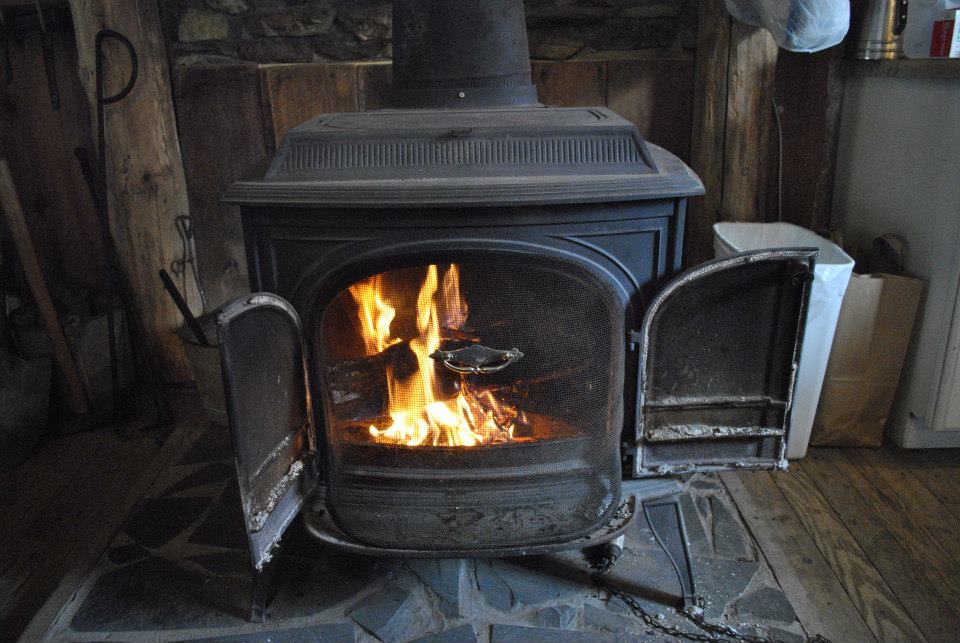 I woke up that first morning to temperatures that felt more like camping in the mountains than living in a house. Wrapped in my covers like a caterpillar in its cocoon, I procrastinated as long as possible, before finally throwing the covers off. Wondering why it felt like there was virtually no heat on, I quickly ran to the bathroom to take a shower and dress. Did the heat not work in here? Instead, I spied my roommate crouching at what looked like a cast iron stove, stuffing bits of wood into it, and then lighting it. “We mostly heat with a wood stove” she explained plainly. I came to be acquainted with the quirks of heating by wood stove intimately over the next six months.
I woke up that first morning to temperatures that felt more like camping in the mountains than living in a house. Wrapped in my covers like a caterpillar in its cocoon, I procrastinated as long as possible, before finally throwing the covers off. Wondering why it felt like there was virtually no heat on, I quickly ran to the bathroom to take a shower and dress. Did the heat not work in here? Instead, I spied my roommate crouching at what looked like a cast iron stove, stuffing bits of wood into it, and then lighting it. “We mostly heat with a wood stove” she explained plainly. I came to be acquainted with the quirks of heating by wood stove intimately over the next six months.
Prior to my first days living in the mountains of the Sierra Nevada, I thought heat was provided via furnace and was adjusted by changing the thermostat — silly me! While we had a very decorative fireplace in the living room of my childhood home, we only used it on holidays and special occasions. I knew fireplaces weren’t very efficient, and were mainly used to provide the right ambience on Christmas eve. So if fireplaces weren’t very efficient, why did my roommate insist on using the wood stove?
Turns out wood stoves are very different than fireplaces. While fireplaces draw air in from the house and send it up the chimney (thus creating drafts), wood stoves are contained completely, so don’t draw air in from the house. They also produce considerable heat, making them very efficient in how much wood they burn and how much heat they produce. In most mountain areas, there is no access to natural gas, so instead residents use stand-alone propane tanks, and propane can be incredibly expensive. Burning wood as your main heat source is much more cost effective than strictly relying on either electric baseboard or propane heat sources.
But when you rely on wood, a lot of work goes into that. Living in Lake Tahoe and Colorado, you can burn three or more cords of wood every winter. A cord of wood is typically 4 feet high by 4 feet wide by 8 feet long or 128 cubic feet of wood. That is a lot of wood! How do you get that much wood? Well the resource is usually all around you. If you’re lucky enough to live on several acres of land, you might be able to secure a great deal of it from the dead and down wood right next to your house. Wood needs to cure awhile before it’s dry enough to burn, so newly cut green trees can’t be used.
In addition, in many mountain states, the U.S. Forest Service issues fuel wood permits during the late summer and early fall. Residents can purchase a permit that allows them to bring in trucks and trailers to collect dead and down wood on Forest Service land. Lastly, if none of these work, you might be stuck acquiring wood the most expensive way — buying it outright.
The work doesn’t end with getting a hold of the wood — it needs to be split and stacked somewhere reasonably close to your house. Some of the wood also needs to be split into finer kindling to get your fire started. During my first winter in the mountains, I really had no idea how to start a fire and quickly found out that each person had their own method — the log cabin method, the tee pee method, etc. What was most important was having enough dry kindling, and enough air to get that fire started. I also found out quickly the difference between hard woods and light woods. Light woods like pine ignite quickly but burn quickly as well. Hard woods like oak burn more slowly and therefore work well for “stoking” your fire before going to bed at night. However, no matter how much you stoke the fire, it inevitably go out before morning or before you return home from work, which meant a lot of practice restarting the fire all over again.
With my years of mountain living between the Sierra and the Rocky Mountains, I’ve learned a lot about fire starting and wood stoves and how best to use them. So it was with some relief and happiness that I discovered that our house in Nederland had the best combination of using electricity and wood to very efficiently burn wood pellets in the pellet stove. No more chopping and stacking for this mountain lady, only the schlepping of a 40-pound pellet bag to pour down the hopper instead. Now I don’t have to worry so much about weight training….

